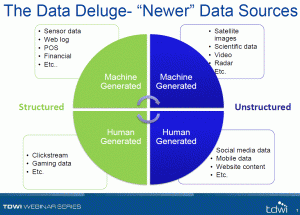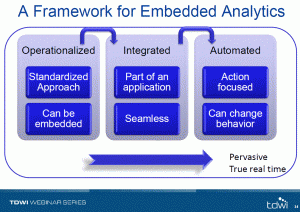TDWI held a webinar to announce their latest major report. While there are always a lot of intriguing numbers in the reports, it’s also important to remember the TDWI audience is self-selecting. People interested in the latest information lean towards the leading edge so their numbers should be taken as higher than would be in the general IT market place. Still, the numbers as they change over time are valuable and the views of the analysts are often worth hearing.
As the webinar was pushing a major report, the full tag team was in attendance: David Stodder, TDWI Director for BI, Fern Halper, TDWI Director for Analytics, and Philip Russom, TDWI Director for Data Management.
David Stodder presented his section first, and one important point he made had nothing to do with numbers. He briefly discussed one quote and user story and it was from a government employee. Companies using Hadoop to better understand internet business and relationships tend to get almost all the press, but David pointed out the importance of data and analytics in helping governments better address the needs of their citizens.
A very intriguing set of numbers David provided was on how many responders were on current versions of software versus older versions. While you can see that some areas are more quickly adopting the SaaS model, that’s not the key the he pointed out. Only 27% of respondents said they’re on the current version of their data security software. A later slide shows that security is one reason for hesitation in the move to mobile, but Mr. Stodder rightly points out that underlying all the information channels is the basis of data security. It’s not a question of if you’ll get hacked but when, so data security should be kept updated.
The presentation was then turned over to Fern Halper. I look a bit askance at the claim that the Internet of Things (IoT) is a “trend.” Her data shows only 18% taking advantage of it today and 40% might be using in within three years. We’ve been talking about IoT for a while, and it’s clearly being slowly integrated into business, I wouldn’t say it’s as fashionable as the word trend would imply.
On the more useful side is the table she showed that’s simply titles “Analytics hits mainstream.” It not only shows that massive adoption of the last decade’s focus on dashboards and BI tools, but around 30% of respondents are using many of the newer tools and techniques and the next three years indicate a doubling in usage.
Philip Russom gave the final segment of the presentation. His first slide on the adoption of newer technologies for data warehousing showed something that many have finally admitted in the last year or no: No-SQL is an excuse made by people who don’t understand how business technology works. While the numbers show 28% of respondents using Hadoop, it also shows 22% using SQL on Hadoop. The number over the next three years are even more interesting: 36% say they’ll be using Hadoop and 38% will be using SQL on Hadoop. That means existing No-SQL folks will be moving to SQL.
The presentation ended with the team of analysts presenting their list of ten priorities for those people interested in emerging technologies. To me, the first isn’t the first among equals, it is set far above all the rest: Adopt them for their business benefits. All the other nine items are how IT addresses the challenges of new technologies, but those things are useless unless you understand how technologies will support business. Without that, you can’t provide an ROI and you can’t get business stakeholders to support you for long. That’s strategy, all the other points are just tactics.
As usual, get the report and browse it.

